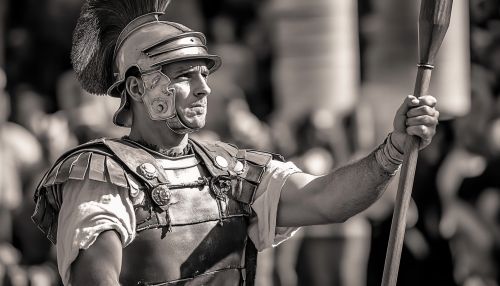Pilum
Introduction
The **pilum** was a type of javelin commonly used by the Roman army during the late Republic and early Empire periods. It was a crucial component of the Roman legionary's arsenal, designed for throwing to disrupt enemy formations before close combat. The pilum's unique design allowed it to penetrate shields and armor, making it an effective weapon in various military engagements.
Design and Construction
The pilum typically measured around 2 meters in length, with a wooden shaft and an iron shank. The iron shank, which was about 60 centimeters long, ended in a pyramidal or barbed point. This design ensured that the pilum could penetrate enemy shields and armor. The wooden shaft was often made from ash or another sturdy wood, providing the necessary balance and weight for effective throwing.


The iron shank was designed to bend upon impact, preventing the enemy from throwing it back. This feature also made it difficult to remove the pilum from a shield, rendering the shield cumbersome and less effective. The barbed point further ensured that the pilum would remain lodged in the target.
Tactical Use
The pilum was primarily used as a ranged weapon to disrupt enemy formations before the Roman soldiers engaged in close combat with their short swords. Legionaries would carry two pila, one light and one heavy, to maximize their tactical options. The light pilum was designed for longer-range throws, while the heavy pilum was used for shorter distances and greater penetration.
Before a charge, Roman soldiers would throw their pila in unison, creating a barrage that could break enemy lines and cause significant casualties. The disruption caused by the pila allowed the legionaries to close in and engage the disoriented enemy with their swords and shields.
Historical Development
The design of the pilum evolved over time to meet the changing needs of the Roman military. Early versions of the pilum had a wooden shank, but this was later replaced with iron for greater durability and effectiveness. The addition of the barbed point and the bending shank were innovations that increased the pilum's lethality and tactical utility.
The pilum became a standard weapon of the Roman legions during the Marian Reforms of the late 2nd century BCE. These reforms, implemented by Gaius Marius, reorganized the Roman army and standardized equipment, including the pilum. The weapon remained in use until the late Roman Empire, although its design and use continued to evolve.
Manufacturing and Distribution
The production of pila was a specialized craft, requiring skilled blacksmiths to forge the iron shanks and points. The wooden shafts were typically produced by carpenters who specialized in military equipment. The Roman state maintained a network of armories and workshops to ensure a steady supply of pila for the legions.
Once manufactured, pila were distributed to the legions through a well-organized logistics system. Each legionary was responsible for maintaining their weapons, including the pilum. Regular inspections ensured that the pila were kept in good condition and ready for use in battle.
Archaeological Evidence
Numerous examples of pila have been discovered at archaeological sites across the former Roman Empire. These finds provide valuable insights into the design and construction of the weapon. Many of the recovered pila show signs of bending and damage, consistent with their use in combat.
One notable discovery was made at the site of the Battle of Teutoburg Forest, where a large number of pila were found. This battle, which took place in 9 CE, saw a devastating defeat for the Roman legions, and the recovered pila provide a snapshot of the weapons used during this period.
Legacy and Influence
The pilum had a lasting impact on military tactics and weapon design. Its effectiveness as a ranged weapon influenced the development of similar weapons in other cultures. The concept of a throwing spear that could disrupt enemy formations and penetrate armor was adopted by various military forces throughout history.
In modern times, the pilum is studied by military historians and archaeologists to understand its role in Roman warfare. Reenactments and experimental archaeology have provided further insights into how the pilum was used and its effectiveness on the battlefield.
